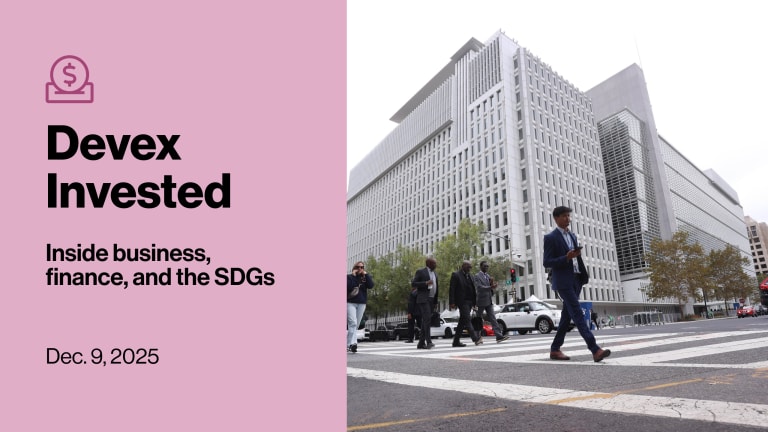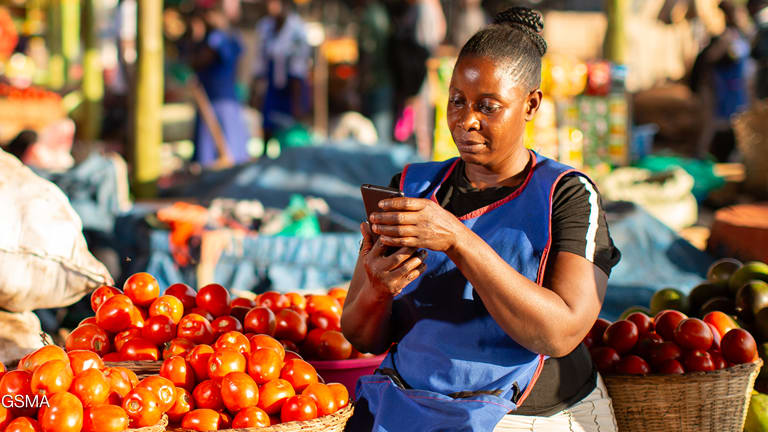
A significant gap in equality between men and women still exists around the world, in everything from economic participation to education, health, and politics. Closing it will require governments, businesses, and finance to change the way they work.
At the current pace, it will take about 134 years to reach gender parity, according to research out last week from the World Economic Forum. More resources are needed to get there — and to that end, the Seven leading industrialized nations’ leaders and a broader group of public and private investors committed last week to invest $20 billion in women’s economic empowerment in the next three years as part of the 2X Challenge.
This is a preview of Devex Invested
Sign up to this weekly newsletter to get the insider brief on business, finance, and the SDGs in your inbox every Tuesday.
Meanwhile, the World Bank is also out with its new gender strategy after a lengthy consultative process. So this week we’ll be taking a closer look at gender-lens investing.
Rising to the challenge
The 2X Challenge dates back to 2017 when the G7 development finance institutions launched an ambitious $3 billion commitment to gender-lens investments by 2020. They more than tripled that target, with more than 50% of those deals to financial institutions that will lend the money to small- and medium- women-owned businesses. Now, as this third iteration of the challenge kicks off — with the private sector officially taking part of the group — more than $33 billion has been mobilized.
But things have changed quite a bit since that first 2X pledge when the gender-lens investing industry was far more nascent. Over the years there have been questions about the robustness of the 2X criteria used to identify gender-lens investments and about whether those investments were actually impactful — including a study last year by Publish What You Fund that found that too little data was available from DFIs about these investments to really be able to determine impact.
I spoke with Jessica Espinoza, the CEO of 2X Global, the independent organization that runs the Challenge, to understand how 2X has evolved.
• The criteria: At the start, 2X developed a set of criteria and an investment qualified if it met one of them. They included whether women were owners or represented on boards; whether the business or fund created quality employment for women or had equality-focused workplace practices; or had products and services that benefit women. It has become the global industry standard. But those standards have now been revised. Among the changes: Qualifying investments should meet two of the criteria, or meet at least one with a time-bound plan to meet a second. The new standards also clarified governance and accountability criteria making sure that there is strategic action and a public commitment to gender equality, Espinoza told me. They have also changed the thresholds of goals to be more specific using benchmarks at the country level based on sector.
• Accountability: Every investment that counts toward the 2X Challenge goes through a peer review process and is reviewed by Espinoza to validate that it meets the criteria. And while 2X has quite a lot of data about those investments, most of that isn’t available publicly. But that will be changing, in part as a response to calls from Publish What You Fund and others, Espinoza told me. Going forward, data about all investments as part of this next three-year 2X Challenge will be published, though in some cases company names will be kept anonymous. It’s a challenge to find the exact data that everyone will agree to release, but 2X is committed to better disclosure, she said.
• Not just box ticking: When I told Espinoza that I’d heard that counting the projects toward the 2X goals was sometimes a bit of a box-checking exercise, she said making sure that’s not the case was a “key motivation” behind the changes to the criteria. Requiring that investments target more than one criteria to qualify should nudge organizations to “further greater impact on multiple levels” — for example, more representation in the boardroom and more products that serve women, or better workplace policies related to gender-based violence and equity and including more of women in the supply chain.
• A new certification: It’s in a pilot phase now, but later this year a new 2X certification mechanism will be launched. It takes the criteria but “developed a broader and deeper methodology” that includes more details on value chains, equal pay, gender-based violence and harassment, and more, Espinoza says. Meeting the criteria will allow for a good certification, but funds or businesses will have to go beyond that to get advanced or best-in-class credentials. For now, the certification will focus on companies and funds — with pricing to be determined but Espinoza says they want to make it accessible for large and small businesses alike.
Also on our radar: What elections around the world mean for gender equality (Pro)
Not yet a Pro member? Access all our exclusive reporting and analyses, members-only events, the world’s largest global development job board, and more by starting a 15-day free trial today.
A new gender fund
Among the initial seven private investors that will officially be part of the Challenge this time around is a newly launched, or repurposed, Global Gender-Smart Fund. It’s a resurrection of sorts of the Microfinance Enhancement Facility, now with a gender mission and a new structure, though it retains many of the same DFI backers. The “largest gender investment fund” will use 2X criteria and aims to improve livelihoods, promote women’s leadership, and enhance gender balance in financial institutions.
It’s a bit of a unique fund in a few ways including that there will be three portfolio managers — Incofin, responsAbility, and Triple Jump. It will also have a technical assistance facility to support investees with advice and support in addition to money. The fund will seek to help its investees create action plans and improve their gender representation, gender policies and other factors.
At a launch event last week one message was clear from those fund managers: Meet the companies where they are and lead with the business case for investing in women.
Strategic shift
Some of you may have been involved in the lengthy consultation process of the World Bank’s new gender strategy — and it finally dropped last week. “It proposes to engage differently,” according to the policy itself.
It will focus on three strategic objectives:
• End gender-based violence and elevate human capital.
• Expand and enable economic opportunities.
• Engage with women as leaders.
Getting there will be measured by six outcomes including progress in ending gender-based violence, more and better jobs, greater ownership and use of economic assets, and more women participating in decision-making.
“In its conceptual framework, the strategy identifies innovation, financing, and collective action as drivers of change toward gender equality,” it says.
The policy will be implemented through engagement at a country level and adapted to the local context, but country partnership frameworks will elevate gender equality outcomes. The bank will also use its data knowledge and advocacy to mobilize action and facilitate reforms or implementation of existing regulations.
What do you make of the new policy? Let me know at adva.saldinger@devex.com.
Contractor conundrum
Staffing changes often rock the boat, and a new policy around short term consultants at the International Finance Corporation has had a rather rocky rollout.
Some consultants were seeing contracts rejected at the 11th hour despite being told they would be renewed for 150 days a year, which they worked this past year, I heard. The new policy, which will limit the number of days a consultant can work to 100 if they’ve worked more than 120 in consecutive years, is aimed at reducing reliance on those contractors and instead hiring more full-time staff. That’s the rationale in some emails and documents I have seen, but IFC declined to comment.
But the abrupt rollout was “horrific” and “surprising,” and some contractors reported that the change in contract terms left them in a lurch financially. IFC will no longer sponsor visas for short-term consultants as part of the policy, though some will get support for one additional year as the policy is implemented. The limitations on days worked will start officially in July 2025.
This is the latest issue in a long history of questions and challenges about how the World Bank group treats short-term contractors. One big question remains: will the rest of the World Bank follow suit?
Read: IFC faces upset over abrupt consultant policy, visa changes
What we’re reading
World Bank’s private sector arm again rejects calls to directly compensate victims of harm at Kenya schools. [The Intercept]
Opinion: Pharma profiteering isn’t going away and so we can’t either. [Devex]
The foundation bringing private sector finance to the World Health Organization. [Devex]
Opinion: Fighting climate finance corruption is everyone’s responsibility. [Devex]








